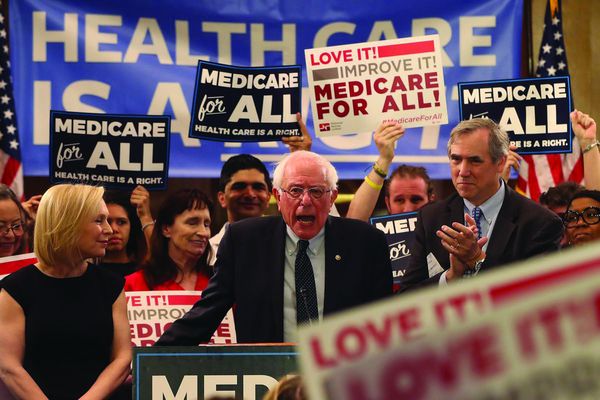Kailyn Nicholson is a member of Socialist Alternative in the US.

The 2016 Democratic presidential primaries engaged a broad layer of young and left voters – many for the first time – thanks to the heated contest between former U.S. Senator and Walmart board member, Hillary Clinton, and self-proclaimed democratic socialist Bernie Sanders. The sharp differences between the two candidates gave expression to a deep and growing polarization among the Democratic voting base. Clinton had nearly universal support from superdelegates, the party leadership, and major corporate donors. Sanders drew such large crowds to his rallies that the campaign struggled to find stadiums big enough to contain them.
Clinton was paid hundreds of thousands for speeches at Goldman Sachs while Sanders raised over $200 million in small donations with no corporate money. Sanders’ campaign and his call for a political revolution against the billionaire class pointed to the need for new party to fight for the needs of working people, while Hillary defended the status quo that led to millions of people losing their jobs and homes after the 2008 financial crisis.
The undemocratic measures resorted to by the DNC to secure the party’s nomination for Clinton convinced many of the party leadership’s deep hostility towards Bernie’s highly popular working-class agenda. Anger at Clinton’s pro-big business, thoroughly establishment character led to lower-than expected democratic voter turnout and allowed Trump to capture all the widespread anti-establishment sentiment among voters.
The stunning victory of Trump was a wake-up call to the party leadership to find a more effective way to win over young and left voters or risk an even deeper division in the party. Over the course of Trump’s first term in office, Democrats have continuously tried to channel public outrage at his sexism, xenophobia, and corruption into electoral support but have refused to mobilize people for a real fight in defense of the rights of immigrants, women, or working people generally. This limited strategy appeared fairly successful in the November midterms, with Democrats running against Trump and the Republicans’ attacks on healthcare and picking up enough seats to win back control of the House, ending two years of single-party reign in Washington.
But instead of wielding their control of the House to launch an all-out fight back against Trump’s presidency, under Pelosi’s leadership House Democrats have adopted a strategy of compromise with Republicans on issues like funding for border security while failing to support impeachment. Meanwhile, they use Trump and the Republican-dominated Senate as excuses for why they can’t fight on key issues for working people like Medicare for All, a Green New Deal, or taxing the rich.
What type of change will the Democrats actually offer if they succeed in taking back the White House next year? That depends to a large extent on how the struggle between the Sandernistas and party establishment plays out in the primaries.
2020 Democratic Primary Field
The number one concern in most Democratic voters’ minds is which candidate will be the strongest opponent to Trump, and Democratic strategists are well aware of the polls showing that Sanders would likely have won against Trump in 2016.
Instead of throwing all their weight behind one clearly establishment candidate early on, Democratic leaders and fundraisers are instead entertaining several potential serious candidates, all of whom are making some attempt to appeal to Sanders’ base. In an amazing shift, most of the Democratic candidates claim to support the most popular elements of Sanders’ platform, including Medicare for All, a Green New Deal, and not taking money from corporate PACs. This shift in rhetoric reflects huge pressure from below, but are these genuine commitments?
Most Democratic candidates are strategically trying to sound like Sanders without actually shifting to the left in a serious way. Young and left voters will be struggling to discern the meaningful differences among a crowded field of candidates trying to blur political differences and stand out by likeability/effectiveness.
But major political differences do exist, particularly between Sanders and Elizabeth Warren, on the one side, and the rest of the pack. These are already evident but will be drawn out more clearly over the course of the primaries. In fact, strong early fundraising both among grassroots and corporate donors indicates the potential for the primary battle to be even more heated and polarized than in 2016.
Joe Biden
Despite declaring late in April, former Vice President Biden has generally led the field of likely candidates in early polls with around 25-30% support. Biden is running on his massive name recognition as many voters harbor a nostalgia for the era before Trump. Biden also has widespread support among the party powerbrokers. One DNC member described him as “a respected party elder and heir to the Obama legacy.” Indeed, many of Obama’s top fundraisers publicly pledged their support to Biden before he declared. For this reason Biden is being touted as a strong candidate to run against Trump, thanks to his supposed ability to “unify the party.”
However, getting the nod from the party establishment is not the golden ticket it once was. High-end fundraisers filled with corporate executives and wealthy celebrities may make for impressive fundraising numbers, but they stand in stark contrast to the growing anti-establishment mood and support for grassroots-funded campaigns.
Biden’s track record makes him both an automatic front-runner for the establishment and also a poorly positioned candidate to win over Sanders’ supporters. There is growing understanding that Sanders is likely the strongest candidate to beat Trump, while Biden shares similar characteristics to Clinton with a long voting record supporting corporate interests. His record includes enthusiastic support for mass incarceration, the Iraq War and the disgraceful treatment of Anita Hill during her testimony about now Supreme Court Justice Clarence Thomas’ sexual harassment.
As the primaries progress, the political differences between candidates are likely to become clearer while the name recognition gap shrinks. It’s entirely possible that Biden could lose his front-runner status to Sanders or another candidate.
Beto O’Rourke
Beto O’Rourke’s national profile developed during his midterm race against right-wing Senator Ted Cruz. Anti-Cruz sentiment built support for O’Rourke among young and left voters in Texas – where Democrats often struggle for support. His strong grassroots fundraising in the first quarter of the presidential race (second only to Sanders) combined with his relative youth and charismatic image as an outsider progressive candidate also raises his appeal as an opponent to Sanders in the eyes of party leadership. While he currently trails Sanders by more than 15 points in the polls, O’Rourke could pick up support from Biden or other establishment candidates as the race progresses and become Sanders’ main challenger.
While doing his best to continue appealing to young and left voters (Sanders’ core base) by pledging not to accept corporate PAC money, O’Rourke is openly courting the support of big-moneyed corporate players. He has received massive donations from big tech and fossil-fuel executives. He opposes Elizabeth Warren’s proposal to break up Amazon and other tech giants and Sanders’ single-payer healthcare bill, both of which would require directly taking on major corporate interests.
O’Rourke has been careful to stake out positions acceptable to big business while giving a nod toward the demands made popular by Sanders. While he claims to support the Green New Deal, he talks about it being accomplished on “sacrifice and service” by ordinary Americans rather than taxing big business to fund it. While at an earlier stage he said he supported Medicare for All, he has since switched to arguing for an establishment plan that would leave the private health insurers in place called “Medicare for America.”
Kamala Harris
Despite being in second place behind Sanders for early fundraising, polls show Harris stuck in the pack of secondary candidates with single-digit support. Harris has been relying for her fundraising on bigger donors and attending a series of high-end Hollywood fundraisers, tapping into the deep-pocketed support she garnered among California’s elite while running for state attorney general and the U.S. Senate.
Harris has announced – and later walked back – support for many of the demands popularized by Sanders in an attempt to show herself as reliable for the ruling class. Like O’Rourke, after claiming to support the elimination of the private insurance industry during a CNN town hall, she later instead indicated she would support more modest reforms that left the industry intact.
After four years of Trump’s blatant bigotry, many voters are understandably excited to support a woman of color for the Democratic nomination. But the radicalization of millions due to the wave of social struggle since Occupy and particularly since Sanders’ 2016 election campaign has made many working people more skeptical of establishment-friendly candidates, no matter their background.
Pete Buttigieg
Thirty-seven year-old South Bend Mayor Pete Buttigieg has garnered widespread media attention and support as an underdog phenomenon, coming from relative anonymity to being fourth in fundraising with 64% of his money coming from small donations. But while his identity as a gay Christian small-town Democrat appears to offer something new and different that could appeal across traditional party lines, his politics are remarkably status-quo.
Since his entry into the race, major bundlers for Obama and Clinton have started organizing big-ticket fundraisers for Buttigieg around the country. He has yet to take clear positions on most major issues, but has already indicated he does not support Medicare for All and instead favors offering a public option. Despite his rhetoric of uniting ordinary Americans from across the political divide, Buttigieg has so far allied himself squarely with the economic and political elite.
Like O’Rourke, with significant forces arrayed behind him and without the long political track record of Biden to weigh him down, Buttigieg could develop into a leading establishment candidate.
Elizabeth Warren
Senator Elizabeth Warren (along with Sanders) is substantially to the left of the rest of the pack on several key issues. In particular, echoing Alexandria Ocasio-Cortez, she has called for a 70% marginal tax on income over $10 million, which many candidates have praised but not supported. She proposes using part of the proceeds from this tax to finance tuition-free public colleges and universities and cancel a huge chunk of government-held student-loan debt.
Warren has also called for breaking up Amazon and other big tech companies to reduce their influence over the political system. While this alone would be inadequate to fully bring the industry and its wealth under democratic control, it proves that Warren isn’t afraid to directly challenge corporate interests. On this topic, most other candidates avoid giving an answer, favoring generalities about the dangers of consolidation and the complexity of regulating the tech sector.
But Warren’s left credentials don’t hold up well in a direct comparison with Sanders. Warren has refused to come out clearly for a Medicare-for-All system. She also stops short of calling herself a socialist, which is a significant part of Bernie’s appeal for many of his supporters. Many remember the 2016 Democratic Primary when Warren was silent until Clinton came out on top, then uncritically endorsed her.
Warren’s biggest political weakness is that she doesn’t point toward the working class as the force that can push back against the power of the corporate political establishment and win progressive change. Instead she implies that simply by getting elected she could convince Democrats in Congress to fight for and pass her proposed legislation – a totally unrealistic expectation given the party’s deep reliance on corporate funding. By contrast, Sanders’ “Not Me, Us” slogan points to the need to build a mass movement of working-class people in order to fight for and win the policies in his platform.
Bernie Sanders
While Democratic leaders like Nancy Pelosi try to downplay support for Bernie’s politics, it’s clear they recognize him as a major threat. In a recent article titled “Stop Sanders Democrats are Agonizing Over His Momentum,” the New York Times noted that top funders and party officials are holding meetings around the country to discuss how to prevent Sanders “complicating their efforts to unseat Trump”, despite many polls that show Sanders would likely beat Trump in a head-to-head race.
Sanders’ recent Fox News Town Hall in Pennsylvania steel country proved beyond doubt that his pro-worker, anti-billionaire message resonates with ordinary voters, including many workers who voted for Trump.
If the Democratic leadership’s first priority were really to defeat Trump, Sanders would be their obvious favorite. If their priority were to reflect the views of their base, who overwhelmingly support taxing the rich and winning Medicare for All, Sanders would again be the clear choice.
Threats of Sanders “splitting the party” don’t make sense in relation to the party base, but are more a reflection of how unacceptable he is to its corporate funders- the very billionaire class he calls for a political revolution against. To take one example, Medicare for All represents a full frontal assault on the $3 trillion for-profit health care industry.
Unlike any of his opponents, Sanders’ program points to the fundamental conflict between free-market capitalism and the needs of working-class people. He does not hide behind carefully-worded polls to excuse refusing to support pro-worker policies like single-payer health care. Instead, he uses his platform to try and counter the dishonest scare-mongering tactics of corporate media and politicians to build popular support for these demands.
Sanders himself does not seek to end capitalism but to reform it. Nevertheless, achieving his program requires building a mass movement against corporate America and the entire capitalist political establishment. A Sanders’ presidency would destabilize U.S. capitalism and give powerful encouragement to working-class struggle in the U.S. and globally. If elected president, he would find himself under assault from big business, with the leadership of his chosen party working against him, and without an organized mass grassroots force to back him up. Overcoming this will require an organized political force, which is why we have consistently called on Sanders to use his campaign to build a new party that fights 100% on the side of working people.
While Sanders does not shy away from his differences with the party leadership in most ways, he unfortunately has not used his campaigns or elected office to build ongoing grassroots movements or a mass grassroots organization to counter the establishment’s power. He also stops short of drawing the full conclusions from the directly hostile role the establishment of the Democratic Party plays in relation to working-class interests, sowing illusions that the Democrats can be transformed.
These mistakes could eventually prove to be a fatal flaw – you can’t win a war if you refuse to identify your enemy or to build your own forces. The Democratic leadership has very clearly and openly identified Sanders as their enemy, and he will ultimately need to do the same or be crushed by them. Even if he does manage to win the presidency, the current crop of congressional Democrats will overwhelmingly stay loyal to the party establishment and fight Sanders every step of the way.
Of course, truly going to war against the party leadership is complicated by the fact that Sanders is currently running as a Democrat, which forces him to comply with a Democratic primary process designed to disadvantage him. The DNC is already taking anti-Sanders primary measures in the hopes of avoiding the messy scandals that plagued 2016, like replacing a number of caucuses with primaries in states where Sanders dominated the caucuses last time. Their hope is to defeat Sanders in such a way that the result will be seen as fair and not obviously rigged – but if the threat of Sanders becomes serious enough they will deploy whatever dirty tactics seem necessary. Sanders’ campaign team and his supporters need to take these obstacles very seriously and have a plan for how to counter them.
Before Bernie launched his campaign, Socialist Alternative argued for him to run as and independent, as we did in 2015. This would have allowed him to bypass entirely whatever rigged process the DNC sets up. Sanders has the name recognition and energetic support base to build and run a powerful campaign without relying on the Democratic primary debate stage to get attention. Despite our disagreement with Sanders’ decision to run on the Democratic Party ticket, Socialist Alternative will energetically campaign for him to win, while raising our proposals to strengthen the campaign.
But if the Democratic Party establishment continues to move to block Sanders in the primary, he should not simply accept this outcome as he did in 2016, but instead take immediate steps to launch a new party for working people. This could include running all the way as an independent. As Clinton proved in 2016, the corporate Democrats cannot be trusted to defeat Trump’s right-populist agenda, and the huge movement building up behind Sanders will need it’s own political organization to mount an effective fight back.



